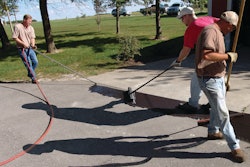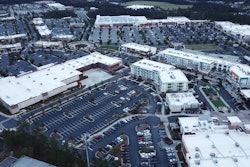
Most contractors know that their toughest job-related decision is how to interpret weather conditions. If it's raining in the morning the answer, unlike the sky, is clear - for the moment. But what about the afternoon? Is there a window of opportunity? Making the wrong decision costs both money and time; so can we make informed predictions about whether and when to put down sealer or paint?
There are four primary factors that will affect whether you should be applying material to pavement and will also have an impact on the dry and cure process. By understanding these factors - humidity, temperature, sunlight and wind speed - and by understanding how these factors affect one another, you can improve your "go-no go" decision making.
Humidity and Its Impact
Humidity is the amount of moisture in the air. The less moisture in the air, the more absorbent the air; the higher the humidity (the more moisture), the less absorbent the air. Consider a dry sponge and a series of 10 plates, each plate holding water. On the first plate the sponge sucks up a lot of water quickly, but the sponge becomes slower and less efficient as you move from plate to plate because the sponge becomes full of water. It works the same way with moisture in the air. The effect is that higher humidity results in a longer time to dry and cure.If humidity is above 90% sealer or paint should not be applied. There's nowhere in the air for the water to go because the air is so saturated.
Temperature and Its Impact
There are two basic types of temperature: Ambient temperature is the temperature of the air; surface temperature is the temperature of the surface a material is being applied to. For the purposes of evaluating and predicting dry/cure conditions we can assume these two temperatures are equal within a certain temperature range. However, it should be noted that in most cases the morning surface temperature is lower than the ambient and in the evenings the surface temperature is higher than the ambient. Basically, it takes the surface temperature longer to change.Temperature is important because the higher the temperature, the faster and farther water molecules bounce, and that's what evaporation is: Molecules bouncing and escaping into the air. So if you heat water molecules they bounce faster and bounce out farther - that's why a higher temperature results in faster evaporation.
A good example is boiling water versus water at room temperature. As water boils the molecules bounce faster and farther because the temperature is high, so the water boiling in the pot will evaporate faster than the water at room temperature. The water at room temperature will eventually evaporate but because the temperature is lower the molecules move slower, don't bounce as much, and evaporation takes much longer. The effect is lower temperatures mean slower evaporation because the molecules bounce slower and not as far, so they don't bounce out of the material into the air where they can evaporate
So higher temperatures aid evaporation; lower temperatures impede it. But temperatures can also be too high for applying material. If they are too high hyper evaporation can cause problems such as delamination of the material. What happens is as water evaporates out of the sealer the sealer links itself together and links itself to the surface. Those actions take some time and if the temperature is too high those actions aren't allowed to happen - the material doesn't have time to bond to itself and to the surface.
That's why most paints and sealers have temperature maximums and minimums because with temperature it can be too cold and too hot (unlike humidity when it can never be too low).
Sunlight and Its Impact
Sunlight is probably the most interesting factor associated with drying and curing. Sunlight is important because it both creates and renews heat. A day with less sunlight means less renewal of heat, which means temperatures are not only lower, they remain lower - resulting in a slower dry and cure time.Assume the surface temperature is 75°F and there's no sunlight. If you apply sealer at 65°F onto the 75°F pavement you change the temperature of the material on the surface to let's say 70°F. If it's a cloudy day and there's no sunlight, there's nothing to renew or regenerate the heat lost. Because there's no sunlight to regenerate heat in the pavement the drying and curing process will be slowed. Can sealer and paint dry and cure without sunlight? Yes, but possibly at a much slower rate.
Wind Speed and Its Impact
The last of the four factors is wind speed, or air flow, which is measured in miles per hour. It's important because, as we saw with humidity, when air is saturated there is no place for water molecules to go - and as we saw with temperature, the heat doesn't change that. The primary factor that changes the saturation level of the air, creating space for water molecules to bounce into, is replacement of the saturated air. That is where wind-produced air circulation comes in.Assume you're putting sealer down on pavement and in a typical evaporation process water molecules bounce around and one escapes. Where does this moisture go? It stays low to the surface because water molecules are heavier than air, so it gets out of the sealer but just sits there. If enough water molecules escape they create a very thin layer of moist air right on the surface of the sealer. In fact, there could be 100% moisture right on the surface of the sealer …if there's no air flow.
But if there's a breeze, say between three and five mph, those water molecules are blown away (much like we blow on things to dry them) creating more less-saturated air right above the surface that other water molecules can bounce into. So wind speed enhances the evaporation process by moving saturated air away from sealer or paint that is drying for a more efficient dry and cure. When there is little or no wind the evaporation process slows. So wind is good, and more wind is better (unless you are in one of our Florida or Carolina hurricanes).
Read more about Driskell Application Factoring scale in Pavement's online exclusive article "A Planning Tool Finds 'Pockets of Opportunity'."
This article was originally published in 2010 by Greg Driskell, president of Professional Pavement Products, Jacksonville, FL.




















